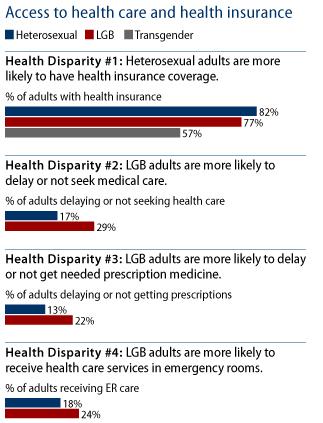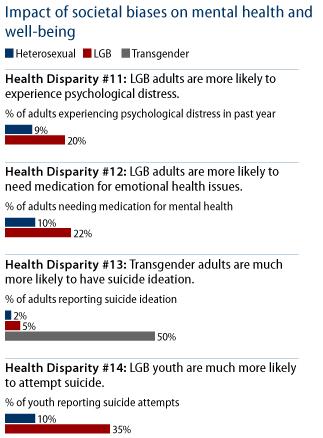Sexual orientation is the classification based on individuals sexual attraction to a particular gender. There are different categories of sexual orientation, such as heterosexuality, homosexuality, bisexuality, and asexuality. While many people think that sexual orientation is a choice of an individual, scientific evidence suggests that a person is born with several orientations. Moreover, as one matures, they discover their sexual status, thus become interested in relationships with a gender they find more attractive on an individual basis. At the same time, some people prefer to hide their sexual orientation due to discrimination from community members. In this light, persons of non-standard sexual orientation are likely to face barriers in accessing health care services. These issues include challenges in getting insurance covers, gaps in treatment, cost-related problems, and underprivileged handling by health care personnel. Therefore, this research discusses the difficulties in access to care by the identified target population as well as which factors have to be regarded by healthcare professionals to prevent, eliminate or minimize the consequences of the problem.
Overview of the Problem
Based on the fact that people of different sexual orientation can be limited in access to healthcare, this population segment may be classified as vulnerable. Vulnerable populations are diverse groups of individuals at risk for poor physical, psychological, and social health outcomes. They are typically medically disadvantaged and underserved. They experience discrimination and stigma because of political marginalization (Pender, Murdaugh, & Parson, 2011). Additionally, vulnerable population has been identified as a group that experiences the greatest burden of health disparities. The value, attitude, culture, and life circumstances of these individuals are socially or culturally different from traditional society and the communities in which they live. All these characteristics should be taken into consideration when planning health promotion and prevention activities. Apart from that, individuals affected by health disparities are, at times, socially and physically isolated. Inequity in healthcare field affects populations who (a) have experienced social or economic obstacle to health, or (b) based on their racial/ethnicity, religion, socioeconomic status, gender, mental health cognitive sensory, physical disability, sexual orientation, geographic location and/ or other characteristics that expose them to discrimination or exclusion (Department of Health and Human Services (DHHS), 2016). Therefore, evaluating health disparities and risk factors that contribute to inequalities requires healthcare practitioners to address individual health behaviors, population characteristics, and environmental factors that are associated with vulnerable populations. In this context, health disparities have impacted their access to health and their overall quality of life for individuals of non-standard sexual orientation.
Place New Order
Health disparities amongst the lesbian, gay, bisexual, transgender (LGBT) community can be evaluated in terms of their access to care, which is measured by their health insurance information. Lack of health insurance can lead to potential health implications or health issues. Thus, a barrier to accessing the insurance contributes to health inequalities. What is more, LGBT individuals are represented in all races, ethnicities, religions and social classes, as well as mixing sexual orientation and gender identity. As a consequence, they face health disparities that are linked to societal stigma, discrimination, and denial of their civil and human rights. On the other hand, DHHS (2016) has reported that over the last few years, rapid progress has been made in securing equal rights for the LGBT community members, such as experiencing positive view and support from people and advocating for equal access to societys basic right opportunities and health care among others.
Nevertheless, the LGBT population continues to experience worse health outcomes than heterosexual individuals and is at a greater risk to certain conditions. Typically, heterosexuals are more likely to report having good to excellent health as compared to individuals of a different sexual orientation (Krehely, 2009). They are affected by number of factors, including a low rate of health insurance coverage, high rates of stress as a result of systematic harassment and discrimination, and lack of competent care in health care system (Krehely, 2009). They remain also at a higher risk for such diseases as cancer or mental illnesses, and more often engaged in unhealthy behavior, for instance, smoking, drinking alcohol, and drug use (Krehely, 2009).
In order to response to the above-indicated problems, the HealthyPeople2020 initiative has been introduced to advocate the need for detailed research, data documentation, and understanding the environmental factors that attribute to the health disparities in the LGBT community. Sexual orientation is not often included in data collection criteria contributing to inadequate estimates of the LGBT disparities. In an effort to accurately account for the LGBT health outcomes and needs, the US government will continue ensuring that data collection includes such information as age, sex, race, ethnicity, primary language or socioeconomic status, as well as sexual orientation and gender identity. This information will provide a record of statistics on health disparities and justified background on how to promote equality (DHHS, 2016). To remove the barriers to health equity, factors that lead to disparities have to be identified. Health promotion focusing on achieving equity health should aim at reducing the differences in current health status and ensuring accessibility to healthcare opportunities and resources to enable individuals to achieve the full health potential.

Discussion of the LGBT Health Disparities
Apart from the above rationale of the problem, significance of this issue is supported with sufficient statistical evidence. According to the Center of Disease and Control (CDC) (2015), men who have sex with men (MSM) accounted for 63% of the estimated new HIV infections in 2010 (n. d.). Furthermore, the institute of Medicine (IOM) (2011) has reported that, LBGT youth have higher rates of suicidal ideation and suicide attempts. Furthermore, the Agency for Healthcare Research and Quality (AHRQ) (2012) has argued that, About 30% of transgender people postponed care when sick or injured and postponed preventive health care due to discrimination and disrespect by providers. Transgender people were most likely to postpone care because of displays of discrimination. Additionally, while access to healthcare by LGBT individuals is limited, as compared to heterosexuals, they are likely to experience severe health consequences (see figure 1).

Figure 1. Statistics on health disparities between LGB and heterosexual individuals provided by the Center for American Progress (Krehely, 2009).
- Our custom writing services includes:
- Plagiarism and AI free custom writing for the best grades;
- CV, resume and cover letters which would
make you successful - Thesis and dissertations writing by academic
authors

Therefore, based on the statistics, sexual minorities are denied insurance coverage by private insurance companies just because of their transgender status. For example, in San Francisco, about 51% of such people do not have the health insurance cover. Without this option, these individuals are not able to access medical services, unless they pay for them which sometimes might be difficult if the medical issue is expensive to solve.
What is more, representatives of the analyzed group of population face discrimination and segregation in access to medical facilities. They encounter poor treatment by healthcare personnel due to such issues as biasness based on their sexual orientation. Over 20% of people with non-standard sexual orientation report that they have been subjected to harsh treatment, abusive language, and even neglected by medical officers, to a certain extent (Pender et al., 2011). Some of them also complain that they have been unnecessarily examined even when their sexual orientation was not related to their health issues. There is also the overwhelming medical gap. In particular, most sexually oriented people do not have access to medical care, and even when they do, the delivered care may not serve their needs. 40% of LGBT people claim that training of health personnel to care for this population segment is not enough (Pender, et al., 2011). This circumstance creates a huge gap between the medical services offered to individuals with distinct sexual orientation and ordinary citizens. About 27 % of individual from this vulnerable group are afraid of medical personnel knowing about their status since they feel that they will be treated differently or even discriminated (Pender, et al., 2011). This factor may result in withholding of information that might be crucial to their health status and overall welfare.
Hence, LGBT persons encounter difficulties in obtaining medical healthcare coverage, gaps in treatment, cost-related hurdles, and underprivileged handling by health care personnel. In this respect, the government should take a step to help these individuals and make sure that their basic needs and necessities are addressed similarly to those of an ordinary person. Furthermore, people with non-standard sexual orientation should elect their representatives who will be able to defend their human rights in the American government. This circumstance will make them feel respected in community. In addition, rigid laws should be put in place to protect these people and guarantee that they will have a normal life granted by the legislation.
Legal Aspect of the Debate on Sexual Orientation
Sexual orientation within the United States is a large concern. Until last year, many people in the US lived in states where same-sex marriages were illegal (State Same-Sex Marriage State Laws Map, n.d.). While same-sex marriage legalization has brought certain positive effect to LGBT community, there are still laws and policies in place that negatively affect individuals with specific sexual orientation. Part of this legislation and regulations directly affect the field of healthcare. To illustrate, the FDA provides recommendations that ask same-sex persons not donate any blood or blood products depending on their sexual history (Center for Biologics Evaluation and Research, 2014). However, these recommendations not only apply to those who are same-sex, but to those who have had any type of curable sexually transmitted illness within the last 12 months, for instance, syphilis or gonorrhea among others.
What is more, some policies even affect the way education is provided because many states mandate sex and HIV education (State Policies in Brief, 2016). Twenty-three states have mandated sex education while only 20 require both sex and HIV education (State Policies in Brief, 2016). Furthermore, Guttmacher has also found that several states must actually teach abstinence in contrast to sexual education (as cited in State Policies in Brief, 2016). According to the Human Rights Campaign (n. d.), many employers incorporate various gender identities in their non-discrimination policies. Nevertheless, passing a state-wide bill, such as the Religious Freedom and Restoration Act, could place judgment into the Supreme Courts hands (Human Rights Campaign, n. d.). When the Supreme Court makes decisions, judges typically rule in favor of the state. Therefore, a residents ruling in one state may differ drastically from another when it comes to religious discrimination (Human Rights Campaign, n. d.).
What are you waiting for?
Order with 15% discount NOW!

Ways to Alleviate the Disparity Associated with Sexual Orientation
In accordance with the findings of the review, LGBT individuals face such disparities that as lack of medical insurance, inability to satisfy their health care needs, overly following through routine tests, and an increased incidence of sexually transmitted diseases (STDs). They also experience higher incidence of recreational drug use, mental disorders, depression, anxiety, and suicide rates (Ard & Makadon, n.d). Moreover, until 1973, homosexuality was listed as a disorder in the Diagnostic and Statistical Manual of Mental Disorders (DSM) and transgender still is (Ard & Makadon, n.d., p. 6). Based on the data of the 1990s, nearly 1/5 of all physicians reported feeling uneasy treating gay patients, and 18% of those doctors treated such patients differently then heterosexual patients (Ard & Makadon). A 2002survey conducted in the United States showed that as much as 6% of physicians still reported that they were uncomfortable treating LGBT patients (Ard & Makadon, n.d).
It follows that simple shifts in practices and modification in perceptions will not provide evident improvements, and there should be specific legal protection for LGBT communities. In this respect, Ard and Makadon (n.d.) have proposed that, intake forms can be revised to be inclusive of a range of sexual orientations and gender identities (p. 7). Another way to alleviate a stressful situation for a LGBT patient is to allow patients to fill out their patient information prior to their first visit. In this way, they will have an opportunity to assess this information on their own and in the comfort of their homes (Robert Wood Johnson Foundation, n.d.). Policies must be put into place at medical facilities that ensure safety for LGBT patients. These individuals must be treated with the same respect as a heterosexual person. They should be addressed with the name they choose (Ard & Makadon, n.d). This factor will help an individual feel comfortable with their environment.
Conclusion
Summarizing the results of the analysis, it is valid to draw a conclusion that the problem of sexual orientation is extremely important for healthcare. When considering the issue of perception and attitude towards sexual minority groups and LGBT communities, the government should introduce new reforms in social and legal spheres. Such an opportunity will help to reconcile and equalize the LGBT individuals needs and requirements with those of people who have standard sexual orientation and make them perceive individuals with a deviated form of sexual behavior in a normal manner. Finally, specific training programs and campaigns should be implemented in support of human rights and freedoms of the target audience, along with the right to self-determination and personal life choices.
